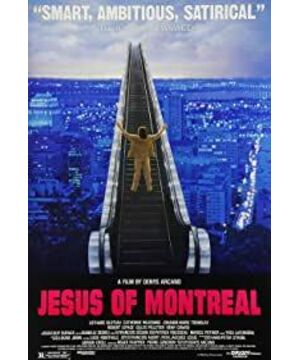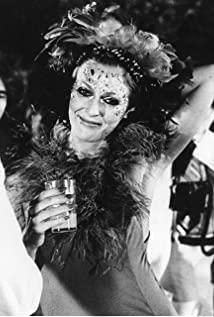This is another film of Denis Argon, known as the "dark horse" of the Canadian film industry, that has attracted the attention of the international film circle after "The Decline of the American Empire".
Denis Argon studied history at the University of Montreal in his early years. When he was a student, he and two other classmates made a feature film "Lonely or in Groups", which reflected the life of college students in Montreal in the 1960s. That was the era of the rise of "direct cinema" in Quebec. Their feature film was indeed assisted and directed by Michel Blau, the founder of "Direct Cinema" in Quebec, among others; that film also became a symbol of the participation of the younger generation in "Direct Cinema". After college, Denis Argon worked in film. He first made several documentaries at the Canadian Film Board, and then went to independent production agencies to shoot feature films. In his more than 20 years of creative career, almost all of his films showed his historical accomplishment and the influence of "direct film".
As a "direct film", he is good at reproducing the atmosphere of contemporary society, politics and economy. As a "history", he observes reality on the basis of future history. Therefore, the specific historical background in his films often goes beyond the simple background. role, and become an entity in the film's narrative. For example, in the 1973 film "Reyana Padovani", it is about a contractor who is dealing with government officials for a hugely lucrative project, while quietly sending people to kill He killed his unfaithful wife, and had the body be put into a prefabricated mold, poured in cement, and exterminated. A highway was being built in Montreal at the time, and contractors did compete to bid and exert all kinds of influence on political officials (wooing, bribing, etc.). The plot in the film where Cente Padovani courtes the Minister of Transportation and the mayor of Montreal is no longer the plot of the film, but a faithful reproduction of the socio-political and economic atmosphere of that period. Reyana Padovani's body, buried in concrete, became a symbol of the conspiracy behind the big project.
Denis Argon is also good at constructing parallel plots, making parallel plots appear in a film to form a critical contrast. The 1975 film "Gina," for example, showed two parallel, intersecting plotlines: a film crew came to a certain place, and the hotel where they were staying had a striptease show. The film crew came here to shoot a documentary about a textile factory. They saw the textile workers working in the factory with harsh conditions. Stripper Gina was gang-raped by a dozen thugs after her performance. The next day her agent brought a group of thugs to avenge Gina. The filmmaker had a working lunch that day with the director of the film bureau and the textile factory manager. At the end of the lunch, the producers announced the cancellation of the filming. Although Gina was abused, she was reluctant to expand the situation and quietly left Mexico. The director of the film also went elsewhere to make another commercial film to make a living... The experience of the film crew and Gina's experience developed in parallel to form a group of contrasts: the director and Gina, the producer and Gina's agent, the thugs And officials, Gina and weavers, and so on. On the surface, Denis Argon just objectively recorded some "facts" that happened in the same place at the same time without commenting. In fact, his comments on society were revealed through this group of comparisons.
Denis Argon's plot structure is obviously influenced by the tragic structure, so depravity and decadence often become the themes of his films. But his "sorrow" is inherent, and as a narrator, he is humorous and calm. In the past, his films explored the tragic status quo of the residents of Quebec living in alienated conditions, and since the 1980s, with the "modernization" of life in the Quebec region, his films touched more deeply on the impact of "modernization" on Western civilization. actual effect. His 1986 film The Decline of the American Empire is one such film. In the late 1960s, there was an "ideological craze" in the West. By the 1970s, this craze was replaced by a general sense of disappointment. People turned from caring about society to caring about themselves, and gradually formed a society that some people call "narcissistic culture". atmosphere. An entire generation abandoned the values of the older generation in favor of "hedonistic" values, and by the 1980s they found themselves in a dead end. From the "sexual liberation" in the 1970s to the "AIDS phobia" in the 1980s, this development process is vividly reflected. The Decline of the American Empire is through the confessions of four men and four women to show the mentality of the modern Western intellectuals, the victims of the "narcissistic culture" who found themselves in a dead end. Although the topic of their confession only revolves around a topic that is currently quite popular but has been banned for a long time in the past - sex, it involves all values other than "sex". The question is posed in an ontological way: what is the point of having children when the world is doomed? Since the result of love is nothing but pain, why should people pursue love? Since the world publishes tens of thousands of articles a day, why do you write any articles? Because your thinking and your thoughts are destined to be submerged in tens of thousands of articles, and like these tens of thousands of articles, they are destined to become rubbish that no one cares about after 24 hours. This is almost a hopeless society, but the attitude of the people is "peace of mind". The film's title, The Decline of the American Empires, is intended to be similar to the historian Gibbons' famous book The Rise and Fall of the Roman Empire, which is more indicative of the original intention of the historically conscious film director Denis Argon to make the film. The Decline of the American Empire earned him a huge international reputation. The film has won more than 20 international awards including the International Film Critics Award at the Cannes International Film Festival.
"Jesus of Montreal" was filmed in 1989. During the preparation of this film, another North American director, Martin Scorsese of the United States, has already started filming "The Last Temptation of Christ". While "The Last Temptation of Christ" caused a stir in the US and Europe, "Jesus of Montreal" was out of post-production and was ready for release. Having two directors at the same time in North America—both of whom were born into devoutly Catholic families—makes films that involve religious beliefs, and the fact that it has an unusual meaning in itself, at least shows that as an American imperial civilization—and a Western civilization at the same time. -- the foundational Christian faith has been crumbling to a considerable extent, thus further confirming the signs of the decline of the American empires. Denis Argonne is more explicit than Martin Scorsese when it comes to denying the "Christian myth". In an answer to a reporter's question, he said: "The Bible is an ancient and mysterious book, full of contradictions, and you can quote it as you want...you can do all the crazy things and claim to be a faithful follower of Christ. Some civilizations were wiped out entirely in the name of Christ. For example, North America wiped out the Indian civilization, South America wiped out the Inca civilization, the Mayan civilization, and so on." Denis Agon is blunt about such traditions. to express disgust. But he also painfully realized that, whether you hate it or love it, the Christian tradition is an inseparable and inescapable part of the human heart in the West. For Denis Argon, its proportion is even greater. His parents were devout Catholics. From primary to secondary school, he has been studying in Catholic Jesuit schools. From such a pious young man to becoming a film director who became popular because he made a film about "sex", what kind of changes have taken place in his thoughts and beliefs in the past few decades, he has never been Opportunity for a concluding review. It wasn't until he suddenly met someone at the age of 45 that he got the idea to make a film about religion, and he felt compelled to take the opportunity to do this retrospective.
Once, he met a bearded actor who came to apply for an actor recruitment for a certain film. The man said, "I'm sorry, but I have a beard because I'm Jesus." Denis Argon initially thought the man was a "paranoiac," before learning that he was employed at a church to perform "Christ" for tourists. Crucifixion" and other religious dramas. Since the location of such performances is the commanding heights of the city of Montreal - the summit of "Mountain King", Denis Argon could not help but be inspired: to perform this millennium social myth in a modern city is ironic in itself. While some unknown or unemployed actors are hired to play roles such as Jesus, if this is a sane actor, it may be possible to reform such performances. The image of Jesus and the profession of the actor are then linked, or even identified, in Denis Argon's conception.
The plot structure of the film "Jesus of Montreal" can be said to be a "parody" of the life of Jesus provided by the Gospel of Matthew in the Bible. A performance is as much a form of communication as a missionary sermon. As an actor, Danielle has also experienced absurdity and humiliation in his life. The actors he recruited were similar to Jesus recruiting disciples. Martin is a versatile actor. However, under what circumstances does the film show his talent to the fullest? - when he dubs two male protagonists of different ages in two porn films at the same time! His talent has no chance to be revealed on the stage, only in the behind-the-scenes world; not in serious drama, but only in the state of artificial eroticism. This is not only a question of absurdity and humiliation, but here is Denis Argon's evaluation of modern media. Although the tone is humorous, we can faintly sense his helpless resentment. This resentment erupted into a violent and destructive protest during the passage in which Daniel made a scene on the TV station and prevented Miley from making a pornographic commercial. However, as actors, they were not willing to let their personalities be buried in vulgarity, and one of Tony's conditions for accepting Daniel's recruitment was to include an entire passage of Hamlet in the new version of his performance of the Passion. monologue. And, under Daniel's leadership, they've finally realized their selves by making a crucifixion drama into a veritable experimental drama. Jesus and his disciples preached in the Middle East not so much to preach the Gospel of the Kingdom of God as to fulfill their ego. In this sense, Jesus is also an actor, just as Daniel is Jesus. Denis Argon said: "Jesus was a hallucinator (seeing visions), a prophet, a miracle-maker. I think he must be able to do magic because his 'miracles' are similar to magic. It is magic, It's some professional tricks that make him admire and convince people." Jesus is like a superstar in contemporary society. Daniel and the image he created (Jesus) are also finally united at the end of the film. According to the Gospel of Matthew, Jesus also experienced a period of delirium called "Little Revelation". I don't know what was wrong with him. Delirium is endless. If before this, Daniel was speaking in the name of Jesus, and he was soberly aware that he was playing the role of Jesus, then by that time the delirium had brought him from fiction to reality, and he had lost the sobriety of the actor. One with the role being played. This is exactly the situation that many people in the performing arts often encounter, in the process of acting, they will encounter some serious "shock" and lose their sobriety and identify with the character. That
Denis Argonne's film "Jesus of Montreal" actually involves a modern reading of such a myth. He blurred the line between fiction and reality right from the start. There is a scene in the film where Miley shoots a commercial promoting perfume. The ad's phrase is "the unsustainable lightness of existence". The audience did not realize that this was a commercial, and thought it was a plot in the film. Denis Argonne deliberately confuses fictional situations with real ones, and uses this as the stylistic tone of the whole film, which subtly points out the need of human society: both belief and questioning of belief. However, the subject is presented in the simplest possible way. In Denis Argonne's words, he just wanted to ask: "Who is Jesus?" "Who is that man we're talking about?" "What do we know about him?" What is life like?" "How are they behaving?" and so on. These, through the unfolding of the plot, the director explained one by one. Denis Argon thought his mission was accomplished. As for what the audience sees, to borrow the words of the priest in the film: "You can prove anything with this script." That is, you can't prove anything. In this way, ancient myths are dissolved in the postmodern version, which is the dissolution of beliefs in the "Empty Age" called "narcissistic culture".
View more about Jesus of Montreal reviews











